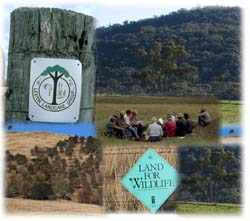Community Attitudes
|
| The successful implementation of Catchment Management Strategies relies on the degree of commitment of the community towards environmental and resource management programs. Australia is predominantly an urbanised country. Therefore, not only the rural community but also the attitudes of the urban population play a vital role. Without the support of the urban population these programs would not be politically sustainable. This section presents the results of a longitudinal monitoring of Victorian's concerns for catchment protection issues and environmental issues in general. |
Sources of information
This report used data from a series of attitude surveys conducted in Victoria between 1988 and 1998. These surveys assessed community perceptions of the seriousness of a number of land related problems. They were conducted with samples from rural areas, provincial towns and Melbourne. In each rural survey approximately 100 respondents were interviewed from each catchment management region. Sample numbers varied for provincial town centres, whilst about 200 were sampled from Melbourne in each survey. Appropriate weighting has been used to compensate for differences in sampling rates between catchments, provincial towns and Melbourne.
Surveys asked respondents to give a score of 1 to 10 to assess the seriousness of a number of environmental issues.
- Soil erosion,
- Pollution,
- Loss of native forests,
- Insufficient waste recycling,
- Salinity,
- Degraded rivers and catchments,
- Extinction of plants and animals,
- Loss of public open space.
This report also produces data drawn from the Australian Bureau of Statistics (ABS) (external link) annual farm census. In 1984, 1989, 1993 and 1994 ABS question asked farmers to report the area of salinity affected land on their farm providing a ten year time series data. This question was used as a measure of perception of salinity.
This report also uses results from opinion studies conducted by a number of organisations, ranging through market research companies, universities and secondary schools. Each provides insights into changing community attitudes at the local level.
Tracking environmental concern
- The degree of concern for environmental issues varied throughout the decade and was related to community concern over economic issues. There was a major shift in the general public opinion on environmental issues between 1988 and 1989 when the environmental issues dominated the party political agenda. Concern for environment dropped considerably by mid 1990s with the acceleration of unemployment in Australia. Concern started to rise again in late 1990s with the fall of unemployment rates.
- For Melbourne residents concern for all issues except for salinity increased between 1988 and 1989 and declined in 1994, whilst concern for salinity continued to rise until 1994 (graph 1). Concern for most of these issues started to rise again by 1997 with the exception of concern for salinity and recycling, which fell from 1994 to 1997.
- The pattern of concern in provincial towns differed from that of Melbourne. The decline in concern for environmental issues in 1994 was less obvious in towns than for Melbourne residents (graph 2). Concern for many environmental issues declined between 1994 and 1997.
- Concern for many environmental issues in rural Victoria increased significantly after 1989. Concern for pollution and recycling followed similar trends to those of Melbourne residents although at a lower level of overall concern (graph 3).
Graph 1

Graph 2

Graph 3

Source for graphs: salinity and weeds awareness surveys (1988-1998)
Urban and Rural Differences
- Pollution, waste recycling and loss of native forests were of more concern to Melbourne residents than land degradation issues. Despite the rise in concern between 1988 and 1994, salinity was the lowest priority throughout the decade except in 1994. Catchment and river issues were middle ranking concerns while biodiversity had a higher level of concern compared to rural landholders. Provincial town residents had greater concern for pollution, forest protection, soil erosion, recycling, and biodiversity. Salinity and catchment issues are of less concern to provincial town residents but still higher than for Melbourne residents. Concern for catchments rose gradually since 1988 and was placed second only to concern for pollution in 1998. Concern for salinity started to drop in 1994.
- Soil and catchment issues were of more concern to rural residents than pollution issues. Salinity and soil erosion were the highest priority in 1988.
- Concern for catchment and rivers continued to rise since 1989 and was ranked highest in 1998. Concern for biodiversity is lower than in urban areas, but has risen significantly since 1989.
- Both urban and rural residents in the Mallee region had higher concern for salinity than in any other region. Concern for salinity was low in the North East region while significant increases in concern were measured in urban Corangamite and rural Wimmera and Goulburn Broken regions.
'Community Attitudes to Environmental Issues: Statewide and Regional Overview' Monitoring Report 44.
To view the information PDF requires the use of a PDF reader. This can be installed for free from the Adobe website (external link).
(PDF 512KB)
Return to Adoption of Best Management Practices main page.



